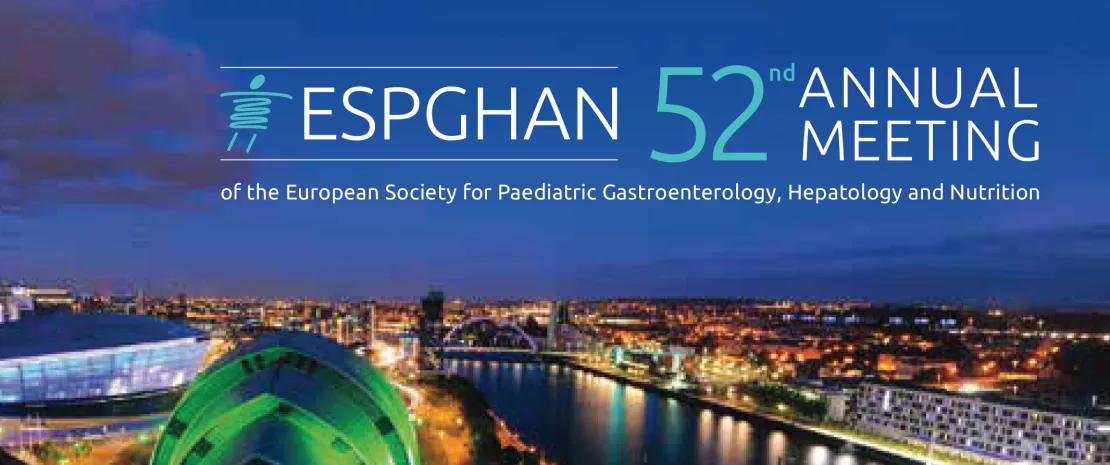51st annual Meeting ESPGHAN
Congress review
By Dr. Solange Heller Rouassant
Pediatrician with specialty in Pediatric Gastroenterology and Nutrition México City, México Mexican Councilor of NASPGHAN
Sources
This article is based on scientific information
Sections

About this article
Author
Gastric microbiota and Helicobacter pylori
Proteobacteria, Firmicutes, Actinobacteria, Bacteroidetes, and Fusobacteria are the most abundant phyla in H. pylori positive and H.pylori-negative patients and this gastric microbiota may play a role in the H. pylori-associated carcinogenicity [1]. Alarcón [2] characterized gastric microbiota in children with and without H. pylori; when detected, H. pylori dominated the microbial community, but when absent, there was a higher bacterial richness and diversity.
Gut microbiota in early life
Development of gut microbiota in early life is influenced by delivery mode, breast milk or formula feeding, antibiotic use, timing of introduction of solid foods and cessation of milk feeding. The gut microbiota of a newborn is transiently dominated by Enterobacteriaceae and Staphylococcus and very soon by Bifidobacterium and lactic acid bacteria. Bifidobacterium-dominated microbiota continues until complementary feeding starts [3].
-
Dukanovic [4] showed that C-section delivery and exclusive breast-feed infants have a relatively low abundance of Bacteroides in the infant stool; Bacteroides species were detected in 73% vaginal and 16% C-section samples.
-
Collado [4] demonstrated shared features between microbiota in maternal-infant pair and breast milk, suggesting a microbial transfer during lactation. Specific strains of Bacteroides, Bifidobacterium, Staphylococcus and Enterococcus genera were isolated from maternal infant gut and specific strains of Staphylococcus, Lactobacillus, Enterobacter and Acinetobacter from paired breast milk at 2 months of age.
Probiotics and synbiotics supplementation in early life
-
It has been reported that association between gut microbiota composition in early life and development of diseases exists [5]. Studies on early infant gut microbiome have shown that antibiotic resistant gene carriage is acquired early and may have long term sequelae.
-
Exclusively breastfed infants were supplemented with Bifidobacterium longum subsp. infantis (Casaburi [4]) as a targeted probiotic capable of remodeling gut microbiome with potential reduction of antibiotic gene reservoirs. It was concluded that colonization of high levels of this strain is a safe and non-invasive method to decrease a reservoir of genes that confer antibiotic resistance.
-
High levels of Bifidobacterium longum subsp. infantis in breast-fed infants, regardless of delivery mode, remained stable through the first year of life if breastfeeding was continued [4].
Infant formula supplementation with prebiotics and probiotics
Human milk oligosaccharides (HMOs) are unconjugated, solid and abundant compounds breast milk. The spectrum of HMOs in mother’s milk especially related to the mother’s secretor status modulates the bifidobacterial composition of the infant’s gut.
Gut of formula-fed infants has a lower relative abundance of Bifidobacteria and a higher microbial diversity. The use of prebiotics in infant formula increases the bifidobacterial fraction in the infant’s gut. Currently, available prebiotics (galacto- (GOS) and fructooligosaccharides (FOS)) are metabolized by Bifidobacteria, but not by the human host [5].
-
Puccio [6] supplemented an infant formula with 2 “fucosyllactose and lacto-N-neotetraose”, commonly found in human milk, with good results. An infant formula with GOS, FOS and Bifidobacterium breve compensates the delayed Bifidobacterium colonization in C-section-delivered infants, modulates gut microbiota and emulates conditions observed in vaginally born infants [6].
-
Comparison of two different infant formula supplemented with prebiotics only or prebiotics and probiotics showed similar gut microbiota profiles than breast-fed infants (Tims & Phavichir [4]).
Cow's milk allergy (CMA) prevention and management
-
Probiotics have been recommended for prevention of CMA even though more evidences are needed. Lactobacillus rhamnosus or Bifidobacterium lactis were administered daily from 35 weeks gestation to 6 months postpartum in mothers, and from birth until the age of two in children. Children that ingested Lactobacillus rhamnosus had a significant reduction of prevalence of eczema in childhood (Wickens [4]).
-
Extensive hydrolyzed infant formulas have been supplemented with L. rhamnosus for the management of IgE mediated CMA and development of immune tolerance. Clinical studies in healthy infants and infants suffering CMA showed that synbiotic-supplemented aminoacid-formulas (AAF) are hypoallergenic, well tolerated, and warranty normal growth.
-
Results of a multicenter, double blind, randomized controlled trial in infants with non IgE mediated CMA was presented (Candy [7]). Infants received a hypoallergenic, AAF formula containing a prebiotic blend of chicory-derived neutral oligofructose and long-chain Bifidobacterium breve . At week 8, significant differences on gut microbiota composition were present between groups, with higher percentages of Bifidobacteria in the symbiotic-AAF supplemented group. Modulation of gut microbiota using specific synbiotics may improve symptoms in infants with CMA.
Infantile colic
Evidence suggests that altered gut microbiota affects gut motor function and induce gas production in infants, resulting in abdominal pain/colic. Manipulation of gut microbiota may play a role in the management and prevention of infantile colic.
- A Cochrane systematic review [4] of prophylactic probiotics in infantile colic included studies of Lactobacillus reuteri, multi-strain probiotics, Lactobacillus rhamnosus, Lactobacillus paracasei and Bifidobacterium animalis. This meta-analysis showed no differences in the use of several probiotics on primary outcome. However, a wider analysis suggested efficacy of probiotics for infantile colic (Ong [4]).







